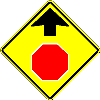Global Navigation

Main Navigation
Sub-Navigation

Content
Over application of our brakes can result in braking force trying to use more traction than we have available. When this happens, our tires break free and begin to slide or skid. Those of us who live in the Northern climes understand this from driving our cars on icy roads. It's just a little more dramatic on our bikes. How we deal with these skids determines the result of the skid.
The most common form of skidding is a rear wheel skid. Assuming we are riding in a straight line on a paved surface, the best thing we can do is to keep the rear wheel locked while we keep our eyes up looking well ahead and the front end pointed straight. If the front wheel is turning and going straight, the back wheel has got to follow it.
Untrained riders often look down when they hear the squeal of the rear tire and because they are pressing on the right side (brake pedal) the bike leans to the right. As the rear tire slides to the left, they ride it down on to the road in what's called a low-side fall. Or they completely release the rear brake (or both of them) and the rear wheel immediately starts turning again. When it does, the gyroscopic effect of the spinning wheel quickly straightens the bike up. The momentum flips the rider, and passenger, over the top of the bike, which is called high siding.
Keeping our eyes focused well ahead helps ensure our bike stays vertical. Keeping the rear wheel locked until we are stopped helps ensure we do not experience the gyroscopic "flip" caused by the wheel quickly going from zero revolutions to rapidly spinning. Our challenge is to not over apply the rear brake and lock the wheel, but once we do, our focus becomes keeping the bike upright. A skidding tire does not stop as quickly as a properly braking wheel, but it does stop much more rapidly than a bike sliding on its side.
Sidebar
Footer
Copyright 1996-2015 Chuck Miles All Rights Reserved
All information on this site, including all articles, are copyrighted materials belonging to Chuck Miles.
Design: Made in Austria | Author: G. Wolfgang



